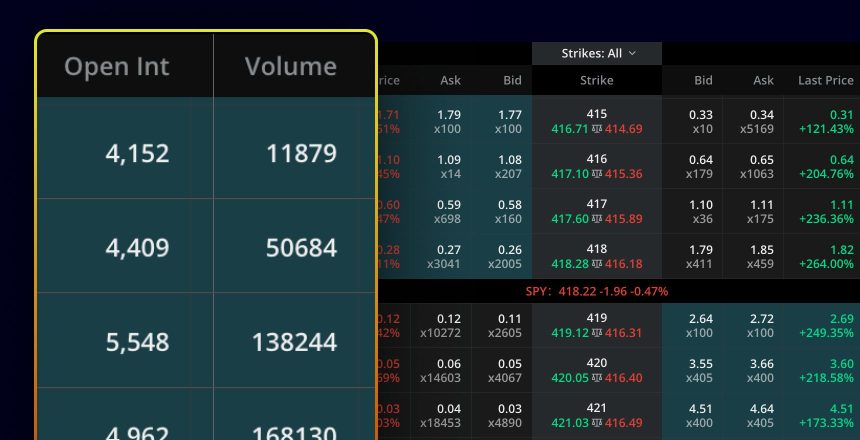As an avid options trader, I’ve witnessed firsthand the significance of open interest and volume in comprehending market sentiment and making informed trading decisions. These two metrics, often intertwined, provide valuable insights into the dynamics of the options market.

Image: www.pinterest.com
Open Interest: A Measure of Outstanding Contracts
Open interest represents the total number of options contracts that are currently outstanding but not yet exercised or assigned. It reflects the number of contracts that are still active in the market. A high open interest indicates that there is substantial activity in a particular options contract, while a low open interest suggests a lack of interest or participation.
Volume: A Measure of Trading Activity
Volume refers to the number of options contracts that have been traded during a specific period. It represents the total number of buy and sell orders executed for a particular options contract. A high volume indicates strong buying or selling pressure, while a low volume indicates a lack of activity.
Interplay of Open Interest and Volume
Open interest and volume are interconnected metrics. A rising open interest typically accompanies a surge in volume, indicating an increase in market activity. Conversely, a decrease in open interest often coincides with a decline in volume, suggesting a decrease in trading enthusiasm.

Image: thefinancialhorizons.com
How to Interpret Open Interest and Volume
When analyzing options market data, it’s essential to consider both open interest and volume. These metrics provide a comprehensive picture of market sentiment and trading activity. Here’s how you can interpret them:
- High open interest and volume: Indicates strong market interest and potential volatility.
- High open interest and low volume: Suggests that a large number of contracts are outstanding but there is little trading activity.
- Low open interest and high volume: Indicates a surge in trading activity but a limited number of outstanding contracts.
- Low open interest and volume: Suggests a lack of interest and minimal trading activity.
Tips and Expert Advice
To enhance your options trading strategies, consider the following expert advice:
- Monitor both open interest and volume: Don’t rely solely on one metric. The interplay of both provides a clearer picture.
- Look for discrepancies: If open interest is significantly higher than volume, it could indicate looming volatility. Conversely, if volume is unusually high compared to open interest, it may suggest a short-term spike.
- Consider the underlying asset: The open interest and volume of an option contract can vary considerably based on the underlying asset.
FAQs
- Q: What is the difference between open interest and volume?
- A: Open interest represents outstanding contracts, while volume measures trading activity.
- Q: How does open interest affect option prices?
- A: High open interest can increase liquidity and narrow bid-ask spreads.
- Q: What are the implications of low volume?
- A: Low volume can lead to wider bid-ask spreads and less liquidity.
- Q: Can open interest be manipulated?
- A: Market makers and large traders can influence open interest through their trading activities.
Open Interest Vs Volume In Options Trading

Image: www.cheddarflow.com
Conclusion
Understanding the significance of open interest and volume in options trading is critical for informed decision-making. By interpreting these metrics in conjunction with the underlying asset and market conditions, traders can gain valuable insights into market sentiment, anticipate volatility, and develop more effective trading strategies.
Are you ready to delve deeper into the intricacies of open interest and volume? Share your thoughts and experiences in the comments section below.






